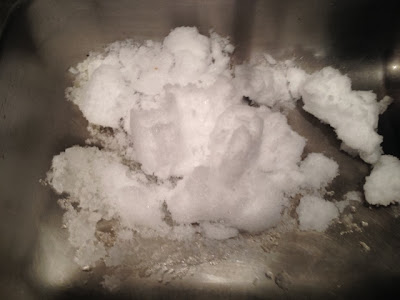When I first started teaching, I taught at a preschool founded on Reggio Emilia theories. My mentor had an amazing way of considering children's interests and merging them with science and art . . . I'm pretty sure that this came from her.
Today, my son, Arden, had a snow day. We spent the morning sledding, but in the afternoon, the snow had turned to rain. It was too rainy to go outside, and he still wanted to play in the snow. Taking my lead from Reggio Emilia theories, I considered his interests - touching snow, scooping, and measuring - and we did this experiment.
Arden measured and scooped the snow into bags:
I held the bags open while he put colors into them. In this one, he mixed blue and yellow.I asked, "What color do you think blue and yellow will make?"
He said, "Brown."
I said, "Let's see if your prediction is right."
We sealed up the bag, and he mashed up the snow. When he saw that the snow was green, he shouted, "Yellow and blue make green!"
I was pretty psyched.
We repeated the experiment with yellow and red and then red and blue. When we were done, we laid out all the bags in rainbow order.

After making all our colored bags of snow, we put the extra snow in the sink.
I asked, "What's going to happen to the snow?"
He said, "It water."
I asked, "So snow is water?"
"Yes," he said. "It cold."
I said, "That's called a phase change. Water can be liquid, solid, or vapor, like steam."
He said, "Phase change?"
I don't think he really got the idea of liquid, solid, or vapor, but he understood that snow was cold water, so I left it at that for today.
Arden especially enjoyed flinging the snow under the faucet.

The connection between Reggio Emilia theories - following student interests to develop a deep understanding of concepts - relates to digital media ideas like the Maker Movement, Connected Learning, and Participatory Cultures (Jenkins et al., 2006) in that playing and exploring are considered to be valuable parts of the learning process. This often makes learning incredibly messy (for example, explaining to Arden that the food coloring wasn't going to come off his hands right away didn't go so well, he was only interested in the project while he was measuring and smashing, and the only color he was truly interested in making was brown, even though I was convinced that making a full rainbow was VERY important), but when he shouted, "Blue and yellow make green!" and explained that snow was water, he was both messing around and learning key scientific ideas.
Also, it was a heck of a lot more fun than staring out the window and wishing we could go sledding some more.
References
Jenkins, H., Clinton, K., Purushotma, R., Robison, A. J., & Weigel, M. (2006). Confronting the challenge of participatory culture: Media education for the 21st Century. Retrieved from The John T. and Catherine T. MacArthur Foundation: http://digitallearning.macfound.org/atf/cf/%7B7E45C7E0-A3E0-4B89-AC9C-E807E1B0AE4E%7D/JENKINS_WHITE_PAPER.PDF.





No comments:
Post a Comment